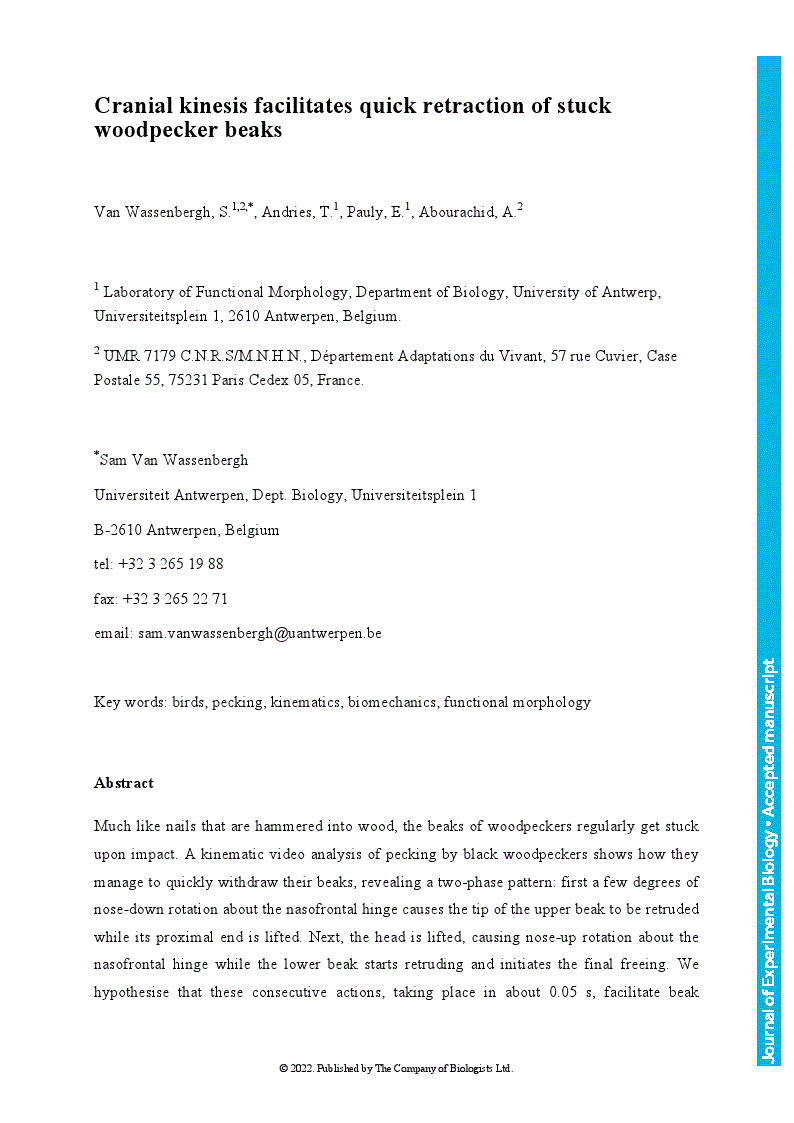Much like nails that are hammered into wood, the beaks of woodpeckers regularly get stuck upon impact. A kinematic video analysis of pecking by black woodpeckers shows how they manage to quickly withdraw their beaks, revealing a two-phase pattern: first a few degrees of nose-down rotation about the nasofrontal hinge causes the tip of the upper beak to be retruded while its proximal end is lifted. Next, the head is lifted, causing nose-up rotation about the nasofrontal hinge while the lower beak starts retruding and initiates the final freeing. We hypothesise that these consecutive actions, taking place in about 0.05 s, facilitate beak retraction by exploiting the presumably low frictional resistance between the upper and lower beak keratin surfaces, allowing them to slide past each other. It also demonstrates the counter-intuitive value of maintaining cranial kinesis in a species adapted to deliver forceful impacts.
Cranial kinesis facilitates quick retraction of stuck woodpecker beaks
- Award Group:
- Funder(s): University of Antwerp
- Award Id(s): SEP BOF FFB190380
- Funder(s):
- Award Group:
- Funder(s): Agence National de la Recherche
- Award Id(s): ANR-16-CE33-0025
- Funder(s):
Currently Viewing Accepted Manuscript - Newer Version Available
- Split-screen
- Views Icon Views
- Open the PDF for in another window
-
Article Versions Icon
Versions
- Version of Record 01 March 2022
- Accepted Manuscript 04 February 2022
- Share Icon Share
-
Tools Icon
Tools
- Search Site
S. Van Wassenbergh, T. Andries, E. Pauly, A. Abourachid; Cranial kinesis facilitates quick retraction of stuck woodpecker beaks. J Exp Biol 2022; jeb.243787. doi: https://doi.org/10.1242/jeb.243787
Download citation file:
Advertisement
2023 JEB Outstanding Paper Prize shortlist and winner

The JEB Editors are delighted to announce the shortlisted authors for the 2023 JEB Outstanding Paper Prize. Read the winning paper - Tiny spies: mosquito antennae are sensitive sensors for eavesdropping on frog calls - by Hoover Pantoja-Sanchez and Brian Leavell from Ximena Bernal's lab at Purdue University, USA.
JEB Science Communication Workshop for ECRs

If you’re an early-career researcher interested in science communication and are attending the SEB Annual Conference in Prague this summer, come a day early and join the JEB Editors at a sci comm workshop to learn the key writing skills needed to promote your research to a broad audience beyond your peers (1 July at 14.30-17.30). Places are limited to 24 attendees, and applicants should apply through the SEB registration page by 30 April 2024.
Bridging the gap between controlled conditions and natural habitats in understanding behaviour

Novel technologies enable behavioural experiments with non-model species, in naturalistic habitats and with underexplored behaviours. In their Commentary, Scholz and colleagues discuss how to obtain a deeper understanding of the natural ecology and lifestyle of study animals.
Beluga metabolic measures could help save species

To help save animals from extinction, it’s important to understand what each species needs to survive. This led Jason John et al. to measure the metabolic rates of captive belugas to develop a ‘fish calculator’ showing that the whales need to eat ~23 salmon per day.
ECR Workshop on Positive Peer Review

Are you an ECR looking for tips on how to write concise, astute and useful manuscript reviews? If so, join the JEB Editors at a 2-hour JEB-sponsored Workshop on Positive Peer Review at the Canadian Society of Zoologists annual meeting in Moncton on 9 May 2024 at 13.00-15.00. There are 25 spaces for ECRs and selection is first come, first serve. To sign up, check the ECR Workshop box when you register for the CSZ meeting.



